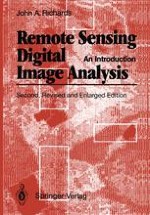1993 | OriginalPaper | Chapter
The Interpretation of Digital Image Data
Author : John A. Richards
Published in: Remote Sensing Digital Image Analysis
Publisher: Springer Berlin Heidelberg
Included in: Professional Book Archive
Activate our intelligent search to find suitable subject content or patents.
Select sections of text to find matching patents with Artificial Intelligence. powered by
Select sections of text to find additional relevant content using AI-assisted search. powered by
When image data is available in digital form, spatially ąuantised into pixels and radiometrically quantised into discrete brightness levels, there are two approaches that may be adopted in endeavouring to extract information. One involves the use of a computer to examine each pixel in the image individually with a view to making judgements about pixels specifically based upon their attributes. This is referred to as quantitative analysis since pixels with like attributes are often counted to give area estimates. Means for doing this are described in Sect. 3.4. The other approach involves a human analyst/interpreter extracting information by visual inspection of an image composed from the image data. In this he or she notes generally large scale features and is often unavvare of the spatial and radiometric digitisations of the data. This is referred to as photointerpretation or sometimes image interpretation; its success depends upon the analyst exploiting effectively the spatial, spectral and temporal elements present in the composed image product. Information spatially, for example, is present in the qualities of shape, size, orientation and texture. Roads, coastlines and river systems, fracture patterns, and lineaments generally, are usually readily identified by their spatial disposition. Temporal data, such as the change in a particular object or cover type in an image from one date to another can often be used by the photointerpreter as, for example, in discriminating deciduous or ephemeral vegetation from perennial types. Spectral clues are utilised in photointerpretation based upon the analyst’s foreknowledge of, and experience vvith, the spectral reflectance characteristics of typical ground cover types, and how those characteristics are sampled by the sensor on the satellite or aircraft used to acąuire the image data.
